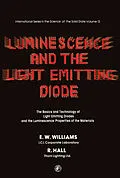Luminescence and the Light Emitting Diode: The Basics and Technology of LEDS and the Luminescence Properties of the Materials focuses on the basic physics and technology of light emitting diodes (LEDS) and pn junction lasers as well as their luminescence properties. Optical processes in semiconductors and the useful devices which can be made are discussed.
Comprised of 10 chapters, this book begins with an introduction to the crystal structure and growth, as well as the optical and electrical properties of LED materials. The detailed fabrication of the LED is then considered, along with the luminescence of the material and the diode light emission. Subsequent chapters explore solid-state lasers made from LED materials; the equipment used to measure luminescence, cathodoluminescence, and diode electro-optic characteristics; and luminescence in gallium arsenide, GaAs1-xPx, and gallium phosphide. Other LED materials such as silicon carbide and ternary semiconducting compounds are also surveyed. The text concludes with a brief chapter that describes some of the applications of LEDs and LED products.
This monograph will be of value to students and non-graduate engineers with an interest in LEDs.
Inhalt
Editor's Preface
Authors' Preface
1 Introduction
2 Introducing LED Crystals
2.1 Crystal Structure
2.2 Band Structure
2.2.1 Direct and Indirect-gap LED Compounds
2.2.2 Alloys of III-V Compounds
2.2.3 Temperature Dependence
2.2.4 Nitrogen Isoelectronic Trap
2.3 Absorption
2.3.1 Fundamental Absorption-Direct-gap Semiconductors
2.3.2 Fundamental Absorption-Indirect-gap Semiconductors
2.3.3 Doped Semiconductors
2.4 Optical Reflectivity
2.5 Phonon Spectra of Zinc Blende Structures
2.6 Electrical Properties
2.6.1 Introduction
2.6.2 Carrier Concentration
2.6.3 Carrier Mobility
3 Crystal Growth
3.1 Introduction
3.2 Phase Diagrams
3.2.1 The Gibbs' Phase Rule
3.2.2 The III-V Compounds
3.2.3 III-V Ternary Alloys
3.2.4 Ternary Semiconducting Compounds
3.3 Melt Growth
3.3.1 Melt Growth of III-V Compounds
3.3.2 Ternary Alloys and Compounds
3.4 Vapour Epitaxial Growth
3.5 Solution Epitaxial Growth
3.6 Molecular Beam Epitaxy
3.7 Electron Beam Plasma Technique
3.8 Conclusion
4 Fabrication
4.1 Material
4.1.1 Gallium Arsenide Substrates
4.1.2 Gallium Phosphide Substrates
4.2 Photoresist Techniques
4.3 Diffusion
4.3.1 Planar Techniques
4.3.2 Review of the Prior Art
4.4 Ohmic Contacts
4.5 Scribing and Breaking
4.5.1 Scribing
4.5.2 Breaking
4.6 Dice Mounting and Wire Bonding
4.6.1 Dice Mounting
4.6.2 Wire Bonding
4.7 Encapsulation
5 Luminescence and Excitation Processes
5.1 Radiative Recombination
5.2 Minority Carrier Lifetime
5.3 Recombination via Defect Centres
5.3.1 Zn-O Complex in Gallium Phosphide
5.4 Auger Recombination
5.5 Basic Equations for Non-equilibrium Conditions
5.6 Optical Generation
5.7 Electrical Injection
5.8 p-n Junction
5.8.1 Current Flow
5.8.2 Emission Efficiency
6 Solid-State Lasers Made from LED Materials
6.1 Criteria for Lasing
6.2 Near- and Far-field Patterns
6.3 Continuous Operation
6.4 Degradation
7 Measurement Techniques
7.1 Photoluminescence
7.1.1 The Basic Photoluminescence Equipment
7.1.2 Microphotoluminescence
7.1.3 Lifetime and Time-resolved Photoluminescence
7.2 Cathodoluminescence
7.2.1 Introduction
7.2.2 The Basic Equipment
7.2.3 Measurement of the Carrier Concentration
7.2.4 Relating Cathodoluminescence Efficiency to LED Efficiency
7.2.5 Lifetime and Diffusion Length of the Minority Carriers
7.2.6 Dislocation Studies
7.3 Capacity Measurements
7.3.1 Optical Injection
7.3.2 Electrical Injection
7.4 Evaluation of Diode Emission
7.4.1 Introduction
7.4.2 Characterization of Emission
7.4.3 Flux Measurement
7.4.4 Intensity Measurement
7.4.5 Colour Measurement
8 Luminescence of Commercial LED Materials
8.1 Introduction
8.2 Impurities and Vacancy-impurity Complexes in Gallium Arsenide
8.2.1 Simple Substitutional Impurities
8.2.2 Band-to-acceptor Recombination
8.2.3 Donor-to-acceptor Pair Recombination
8.2.4 Auger Recombination
8.2.5 Carrier Concentration Quenching
8.2.6 Vacancy Complexes
8.2.7 Other Defects and Impurities
8.3 Impurities in Gallium Phosphide
8.3.1 Introduction
8.3.2 Donor-acceptor Pairs
8.3.3 Nitrogen and Bismuth Isoelectronic Traps
8.3.4 Gallium Vacancy Complexes
8.3.5 Conclusion
8.4 Gallium Arsenide Phosphide Alloys
8.4.1 Direct-band-gap Material
8.4.2 Indirect-band-gap Material
8.4.3 Temperature Dependence
9 Light-Emitting Diode Survey
9.1 Introduction
9.2 Electrical Characteristics
9.2.1 Effect of Temperature
9.3 Optical Characteristics
9.3.1 Encapsulation
9.3.2 Effect of Absorption
9.3.3 Temperature Dependence
9.4 Gallium Arsenide
9.4.1 The Efficient Silicon-doped Diode
9.4.2 Other Diodes
9.5 Gallium Phosphide
9.5.1 Red-emitting Diodes
9.5.2 Green-emitting Diodes
9.5.3 Yellow-emitting Diodes
9.6 Gallium Arsenide Phosphide
9.6.1 Effect of Nitrogen
9.6.2 Effect of Substrate
9.6.3 Characteristics of Commercial Devices
9.6.4 Colour
9.7 Indium Phosphide
9.8 Other III-V Compounds
9.9 Other III-V Alloy Systems
9.9.1 Direct; Indirect-gap Alloys
9.9.2 Direct-gap Alloys
9.9.3 Indirect-gap Alloys
9.10 Two-photon Phosphor Diodes
9.11 Silicon Carbide Diodes
9.12 Ternary Chalcopyrite Semiconductors
9.13 Conclusion
10 Application of LED Products
10.1 Introduction
10.2 LED Indicator Lamp
10.2.1 Range of Applications
10.2.2 Special Indicators
10.3 Alpha-numeric Displays
10.3.1 Application of LED Displays
10.3.2 Bar Graphs
10.4 Optically Coupled Devices
10.4.1 Laser Diodes
10.5 Future Prospects
Author Index
Subject Index
